Keeping the rubber on the road can be tiresome, particularly for RVers. For example, our tow unit is a 1-ton “dually,” that requires six tires on the pavement, then add the four tires on the trailer we pull (not to mention the spares) and there are ten tires to be looked after.
How about you? Is it safe to buy and run used tires?
The folks at Consumer Reports recommend you steer completely away from used tires. Their reasoning is simple: you don’t know a thing about the background of the tire, who owned it, nor how they treated it.
Since you can’t tell everything you need to know about a tire from a cursory inspection, the group best known for testing consumer products says,
“The tire could have been driven overloaded, underinflated, or to excessively high speed. Any one or a combination of these factors could lead to internal damage not visible from the outside. In short, the used tire could be unsafe.”
But again, money talks. What if you decide you really do need to buy a used tire or two (or ten)? Here are some things to look for as you carefully examine a potential purchase.
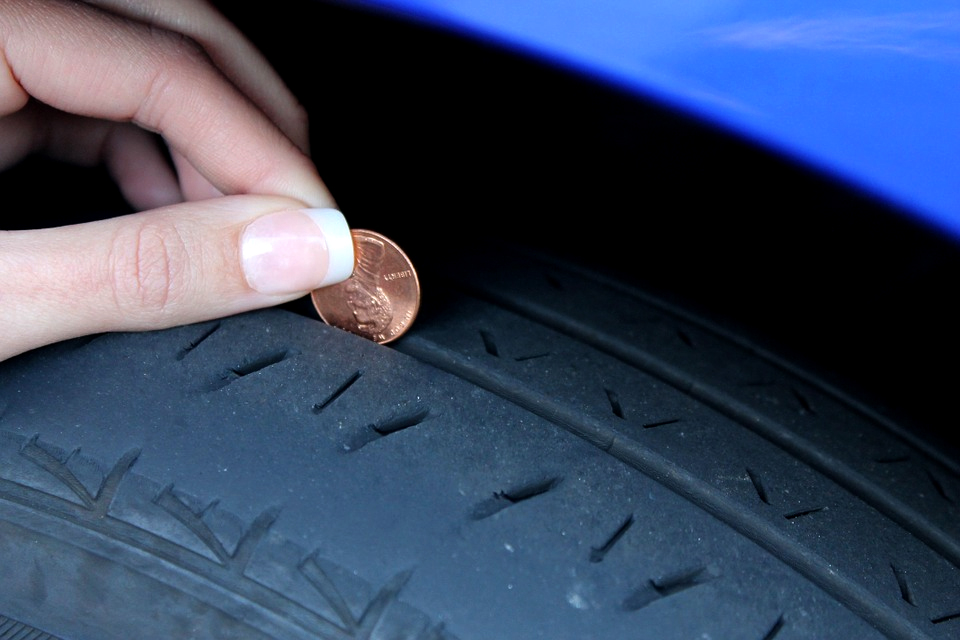
While a depth gauge is a good idea, a penny will tell you if the tread is deep enough.
How deep is your tread?
If you don’t have a tread depth gauge (and you really SHOULD have one), then the old standard of sticking a penny, head down in the tread, tells the tale.
Mr. Lincoln’s head should be at least partially covered. If you can see all of the penny’s head, the tread is worn out.
Separate yourself from a separation
Check out the sidewall and the tread area. Beware of any bumps, irregularities, or wavy-looking areas. They could mean the tire’s been damaged and can be separating or delaminating.
Take it from our personal experience—a tire separation led to some serious damage on a Utah highway that spelled a total loss on one of our tow vehicles.
Don’t just look–run your hand along the sidewall and tread surface areas and feel for anything unusual.
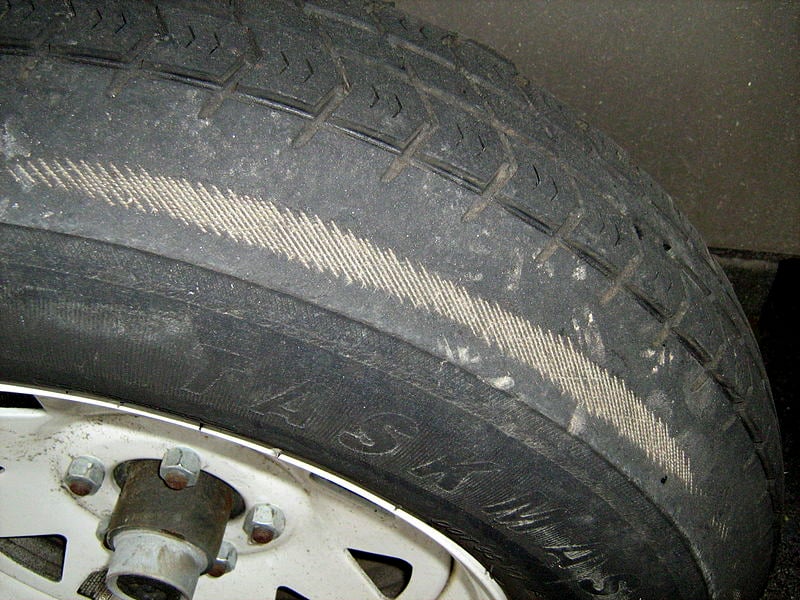
Seeing the innards of a tire? Walk away!
CZmarlin — Christopher Ziemnowicz, releases all rights but a photo credit would be nice if this image is used anywhere other than Wikipedia., Public domain, via Wikimedia Commons
Don’t sing on the wrong cord
Roll the tire around carefully and examine the entire length of tread. You shouldn’t see any cord, nor any trace of wire coming through.
Beat up beads
A tire’s bead area is where the tire meets the metal rim of the wheel. That bead needs to be solid, not chunked or damaged, to ensure a complete and safe seal.
While you’re looking, check the sidewalls of the tire for small cracks indicating the potential of dry rot. They may appear, too, between the blocks of the tread. Dry rot is a sure sign of problems.
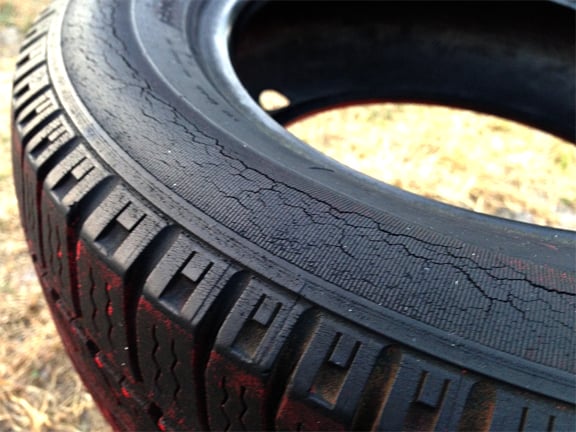
Sidewall cracks can lead to a blow out. But watch for cracks on the tread surface as well.
Cracks lead to crack-ups
So-called “weather checking” on sidewalls, and at times in the tread surface, lead to tire weakening. A blown tire, at best, can ruin your whole day. Exposure to ozone is the usual cause for such cracking, and there’s no cure for it.
Peek inside
The inside of the lining of the tire should be carefully looked at. If a tire has been run overloaded or low on air, the sidewall begins to collapse. If that happens, they can fold over and contact themselves, rubbing, scrubbing, and damaging the interior of the sidewall.
If you see a wear stripe around the inside of the sidewall or spot any tiny particles of rubber in the tire, or if you see the inner surface of the tire sidewall, reject the tire.
Rejectable repairs
Not all tire damage is bad. A puncture, properly repaired, can be OK. But a safe repair is a patch on the inside of the tire, not a “plug” of rubber pushed through the puncture. If a puncture is larger than ¼ inch or is within an inch of a sidewall, don’t buy the tire.
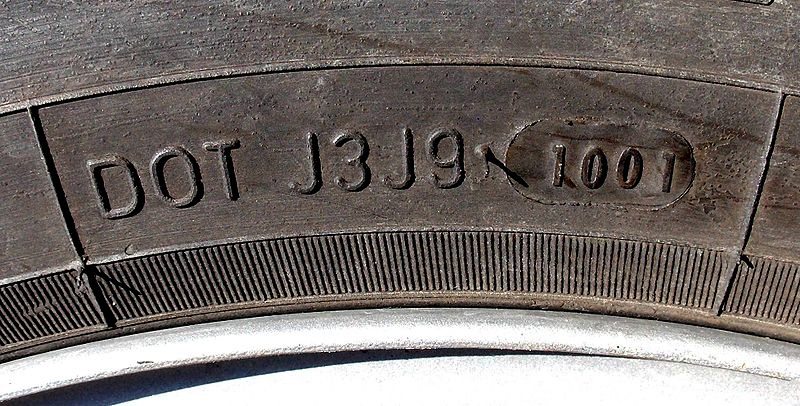
Don’t miss this important date. First two digits are the production week, the last two the year of manufacture.
Hot dates
A tire may be undamaged and have loads of tread left on it, but if it’s aged, it’s not a safe tire. When we say “aged,” it’s recommended you never buy a used tire that’s any older than five or six years.
A tire that’s seven years or older really needs to be replaced. How do you know how old the tire is? Look on the sidewall for the DOT code: the letters DOT, followed by several numbers, are the code. The numbers are the key: the first two are the identification code of the tire plant where the tire was made.
The next four numbers are the date of manufacture–the first two of those are the week, the next two are the year. So the four digits “1001” tell you the tire was made in the 10th week of 2001.
Yep, it’s better to spring for a new tire when you can. But if you’re in a bind, checking these potential failure points can go a long way to keeping your used rubber rolling down the road without a disaster.
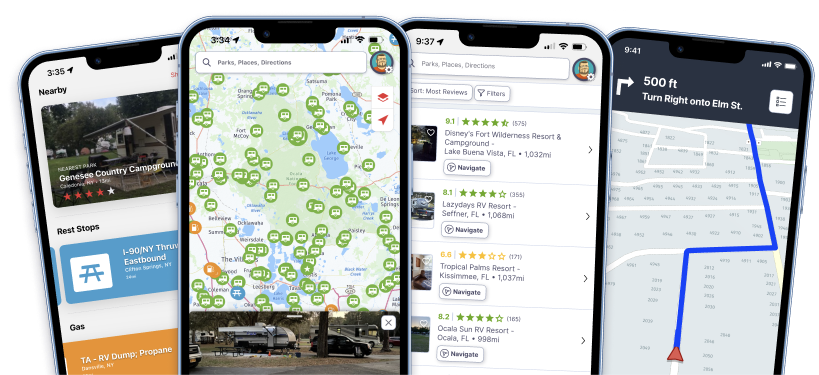
No. I think why should be obvious. No on any vehicle.
The real question should be, is selling your used RV tires a good idea. Maybe trucks can use tires that are a little old but have a lot of tread on them.
I do not trust Consumer Teports at all after the Suzuki Samurai fiasco where they manufacured false information about rollover tendancies in order to create sensationalism to sell magazines and pay for their new office building back in the 1980’s.
Regarding used tires, become your own expert on tires in general, then decide for yourself. Don’t fall for the scare tactics foisted on consumers designed to separate them from their money by using the date ploy. Even new tires with low miles can fail catasrophicly, just look up Firestone history.
You failed to mention that Suzuki tried to justify the handling of its Samurai by comparing it to the Ford Bronco II. Consumer Reports tested the Bronco II and found it, too, rolled over too easily. The Bronco II was quickly discontinued, and so was the Samurai. Two unsafe vehicles were identified and replaced with safer models. I trust Consumer Reports more than anyone who needs to go back 40 years and cherry-pick a single incident which occurred in the 1980’s..
Suzuki sued for $60 million in damages and unspecified punitive damages for what Suzuki claimed was willfully fraudulent testing.[4] However, after an 8-year legal battle and several dismissals of Suzuki’s claims against CU in Federal courts, CU and Suzuki settled out of court through mutual consent in 2004.[5]
“Settlement
Quoted from Wikipedia – In the settlement, CR agreed that it “never intended to imply that the Samurai easily rolls over in routine driving conditions.”[6] A joint announcement of the settlement stated that “CU and Suzuki disagree with respect to the validity” of CU’s tests. “Suzuki disputes the validity” of the tests, and “CU stands by its test protocol and findings
My side, your side and the truth. Yes, I usually trust Consumers Report.
i rather run a used Michelin car tire on my trailer than some of new chinese ones.
Not if you want to take it on the road. and they say run your hand over the tread and side wall you might not see a the steel ply sticking out to bite your hand untill you feel it and have a dirty cut .
How about the opposite? Buy fresh tires, use them for 3 or 4 years then sell them to truckers as full tread tires?
So YOU pay the full cost and then get rid of the tires before you are bad? Where is the sense in that? It is literally NO benefit to you, the one cracking open your wallet.
I am shocked at the crazy religious posts here about New American only tires. Do you put on a new set before each trip? No? Then you are driving on used tires.
I agree with the article unless you know who the previous owner is and can verify the history of the tires and the mileage.
USED TIRES??? I’LL WALK AND BACKPACK BEFORE I BUY USED TIRES REGARDLESS OF AGE OR WHO HAD THEM BEFORE.
I would NEVER tow a trailer with anything less than top-quality AMERICAN MADE tires. After pulling a factory-new 30′ fiverr less than 50 miles from the dealer, the two Chinese/Japanese tires on the right side exploded into a million pieces. Spent a leisure afternoon awaiting replacement of all four with a new set of Coopers (made in Arkansas!) while talking to the police, firemen, locals in general. NOT worth it!
Anyone who tows a trailer is an IDIOT if they buy used tires. This article is so basic that it is SCARY to think that any RVer would not know all about this.
Totally agree, It’s not just so much an IDIOT that does this, but also a CHEAP SKATE and probably shouldn’t be RVing to begin with. Can’t afford to maintain and RV, then find another Hobby!
sorry but i disagree, the IDIOTS are the ones that religiously replace their tires every year. fact is if it has tread, not abused and not cracking there is no reason to buy new tires. fyi i can think of a few reasons to buy used tires and it contrary to popular belief it has nothign to do with being an idiot or cheap by any means.
sorry but i disagree, the IDIOTS are the ones that religiously replace their tires every year. fact is if it has tread, not abused and not cracking there is no reason to buy new tires. fyi i can think of a few reasons to buy used tires and it contrary to popular belief it has nothign to do with being an idiot or cheap by any means. as an example: you need to tow your rv ( motorhome in this case) and the tires are all dry rotted and cracking and you are not yet ready to replace all the tires but it cant be towed with the current tires. another example would be you buy a used rv with bad tires and need an interim till you can order ( or in alot of cases it appears these days even find and i will give an example of hard to find tire by size 255/70R19.5).
the only true idiots are those that have more money than brains and will continuously throw money away every 7 years especially now with bidenflation but i assume a lot of people are lookign at gas prices and not bothering to go rving right now.
Not that it matters, but the only tire problems I’ve had were with new American made tires, not any of the used tires I’ve bought. But I do think used tires are ok for vehicles under 4,000lbs. but should be new Michelins for over 4,000lbs. I’d never consider Chinese tires for trucks/cars, but maybe ok for scooters and bicycles. For heavy RV’s buy American, especially Michelins.
sorry pete but i disagree with this statement, i have had more michelin, goodyear and bf goodrich tires fail than some of the other brands on the market including “chinese” ones. however, i personally do try to avoid chinese brands if possible on basic principle of id rather support us or another countries workers but in my experience even new tires can be bad even name brand american and of course the tires will ALWAYS fail after your warranty has expired so no reason to shell out $350 to $500 per tire on a motorhome especially if replacing 6 + a spare or more.
currently i myself have one of those reasons to buy used tires which is my motorhome needs towed from 150 miles away but the tires are shot, i replaced 2 of the rears with used and still have to replace the other 2 rears before towing and budget will not permit tires AND towing at this time and buying a pair of new tires only to be replaced with a brand new set of 7 ( 6 and spare) would be a complete waste of money. also used tires are good to keep on hand to be used as spares. i tend to keep 1 used tire as my spare tire which saves some on cost
If an average of seven years for your rv tires when buying new why buy used and how much do you evaluate your family’s safety and the other people on the road if you have a blowout
I’m sorry but years of experience makes me disagree. We ran dry rotted , old, and recaps for 22 tons of steel. Only the drivers who did not check the tires inflation EVERY run, had issues. These trailers some times sat for months with no use. The important part is to have tire monitors that let you know, in the passenger compartment, immediately if a tire has an issue. Under inflation is the number one cause of tire failure. NOT age.
Agree.
If you have an RV don’t compromise your tires, maybe you should consider getting something that you can afford. Always put new tires on ,otherwise get rid of it. It must be out of your Budget.
Everyone calm down. If you can find used tires with a recent date and no issues , then buy them if you want. Most of them come from one or two US reputable suppliers that buy them from insurance companies when a vehicle is totaled. They have been culled for flaws before they buy them in the first place.
A reputable used tire shop buys tires from them in mass quantities ( like hundreds at a time). They have trained people that inspect and cull the tires a second time. These stores offer a warranty.
You can save lots of money. Imported new tires can be far more dangerous than a US made used one.
Oh and shame on people that call used tire owners idiots NOT used tire owners.. Some people have tight budgets and an RV. Saving money is nothing to be ashamed of.
Here is the thing:
My hubs is an engineer. He designed tires for a huge US manufacturer. Then he designed warehouse distribution systems. He saw every manufacturer and noticed which ones had issues.
He is considering opening a used tire shop chain. The due diligence on the insurance alone is staggering and required many hours of research on used tire safety.
Our next set will be used if we can find what we need. But what does he know….
So if you find a reputable used tire retailer that has more than a hole in the wall location and buys their tires in bulk from a reputable source, why not?
But what do I know…
One thing missing from this article that I learned a long time ago about rotating tires, (and this would apply to used tires) — all steel belted tires have a memory of what direction they have been traveling in. So when tires come off a vehicle, they should be marked with a grease pencil as to the “forward” direction they normally travel. If you put a tire on backwards (reverse direction) you could face significant trouble.
Putting your wallet before safety is foolish and dangerous. If you cannot afford new tires, please park your rv until you have saved enough to purchase new.
I don’t understand why everyone is so scared of used tires! Your RV is just going to sit compared to your car. You will NEVER put as many miles on RV tires as you could, they will be too old to leave on the vehicle and you’ll see sidewall cracking. New tires become used tires the second they are installed and can handle punishment, that’s what they are made for. Letting someone put a bunch of miles on the tires for a couple of years and then let you buy them cheap is a PERFECT use for old tires. Then they sit in the sun and bake until it’s time to go on vacation again. Keep them for 8 years or so and then buy another set of used tires.
The biggest warning on RV tires is to NOT let them age out, very easy to do if you are concerned about how expensive a new set of tires can be.